

Sub.mesa. Navigation: back to FreeBSD setup Guide.
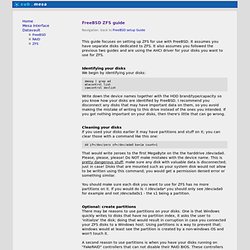
Remote Installation of the FreeBSD Operating System without a Remote Console. Copyright © 2008 The FreeBSD Documentation Project FreeBSD is a registered trademark of the FreeBSD Foundation.
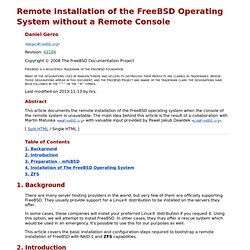
Many of the designations used by manufacturers and sellers to distinguish their products are claimed as trademarks. Configuration des périphériques iSCSI avec COMSTAR - Administration d’Oracle Solaris : Périphériques et systèmes de fichiers. Configuration des périphériques iSCSI avec COMSTAR Vous pouvez définir et configurer une cible COMSTAR Internet SCSI (iSCSI) et la rendre disponible sur le réseau.
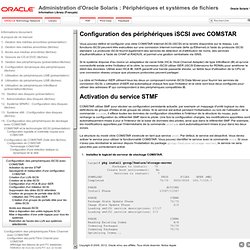
Les fonctions iSCSI peuvent être exécutées sur une connexion Internet normale (telle qu'Ethernet) à l'aide du protocole iSCSI standard. Le protocole iSCSI fournit également des services de détection et d'attribution de noms, des services d'authentification à l'aide de CHAP et RADIUS, et permet une gestion centralisée via iSNS. Where's all my memory gone? Solaris 10 ARC memory usage with ZFS - My South. On the other day, I just wanted to know how many memory my system is using really for its purposes.
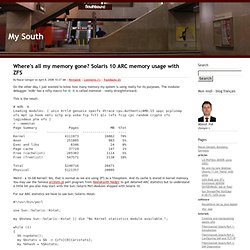
The modular debugger "mdb" has a nifty macro for it: it is called memstat - really straightforward. This is the result: # mdb -kLoading modules: [ unix krtld genunix specfs dtrace cpu.AuthenticAMD.15 uppc pcplusmp ufs mpt ip hook neti sctp arp usba fcp fctl qlc lofs fcip cpc random crypto zfs logindmux ptm nfs ]> ::memstatPage Summary Pages MB %Tot------------ ---------------- ---------------- ----Kernel 4111973 16062 78%Anon 251805 983 5%Exec and libs 6346 24 0%Page cache 37719 147 1%Free (cachelist) 285302 1114 5%Free (freelist) 547571 2138 10% Total 5240716 20471Physical 5121357 20005.
ZFS tip of the day. Auto-backup.sh. Zfs auto-replicate script. Less known Solaris Features: iSCSI with COMSTAR - c0t0d0s0.org. A while ago, i wrote a tutorial about using iSCSI in Opensolaris and Solaris 10.

While the tutorial is still valid for Solaris 10, Opensolaris got a new, more efficient iSCSI Target. iSCSI in Opensolaris is a part of a more generic in-kernel framework to provide SCSI Target services. This framework isn't just capable to deliver iSCSI, you can have FCoE, SRP, FC targets as well. This generic approach led to a different administrative model. Thus when you want to configure iSCSI on a OpenSolaris system and you want the new framework (the old userland based version is still available) you have to configure the target side differently.
This tutorial will do pretty much the same than the old iSCSI tutorial, just with the new framework to give you an overview about the changes. Sbdadm. iSCSI SAN - Part 1: The Server (The Observatory) If you have OpenSolaris as part of your home network, you can put that box to work as a storage server accessible by the other machines on your home network, regardless of their operating system (Linux, MacOS, Windows).

There are generally two approaches you can take to create a storage server: Networked-attached Storage (NAS) or Storage Area Network (SAN). With NAS, both the storage and the file system are provided by the server and it is clear to the client that the storage is remote. I wrote up an example of this approach earlier in the year: Accessing OpenSolaris Shares from Windows. This is probably the more common approach for home use. With SAN, only a block level device is provided by the storage server and it's up to the client to provide the file system. ZFS Tutorial Part 1. Source Tour (Community Group zfs.source. [ odg ] This page is designed to take users through a brief overview of the source code associated with the ZFS filesystem. The Blog of Ben Rockwood.
ZFS is an amazing in its simplicity and beauty, however it is also deceivingly complex.
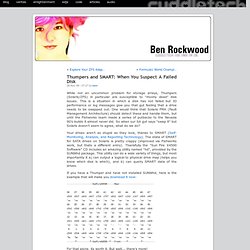
The chance that you'll ever be forced to peer behind the veil is unlikely outside of the storage enthusiast ranks, but as it proliferates more questions will come up regarding its internals. We have been given a tool to assist us investigate the inner workings, zdb, but it is, somewhat intentionally I think, undocumented. Only two others that I know have had the courage to talk about it publicly, Max Bruning who is perhaps the single most authoritative voice regarding ZFS outside of Sun, and Marcelo Leal. In this post, we'll look only at the basics of ZDB to establish a baseline for its use. Running "zdb -h" will produce a summary of its syntax.
In its most basic form, zdb poolname, several bits of information about our pool will be output, including: ZFS Deduplication: To Dedupe or not to Dedupe... ...that is the question.
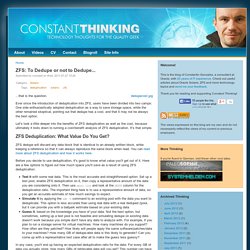
Ever since the introduction of deduplication into ZFS, users have been divided into two camps: One side enthusiastically adopted deduplication as a way to save storage space, while the other remained skeptical, pointing out that dedupe has a cost, and that it may not be always the best option. Let's look a little deeper into the benefits of ZFS deduplication as well as the cost, because ultimately it boils down to running a cost/benefit analysis of ZFS deduplication. It's that simple. ZFS Deduplication: What Value Do You Get? ZFS dedupe will discard any data block that is identical to an already written block, while keeping a reference so that it can always reproduce the same block when read. Before you decide to use deduplication, it's good to know what value you'll get out of it.
Test it with some real data. Now take your total amount of storage and divide it by the dedup ratio, then subtract the result from your total amount of storage. Www.filibeto.org/~aduritz/truetrue/solaris10/zfs/zfs-internals-leal-0.1draft.pdf. Zdb: Examining ZFS At Point-Blank Range « Cuddletech. Reflections on 25 Years of LEAN Gemba Academy has posted an extremely interesting series of videos entitled: Reflections on 25 Years of LEAN.
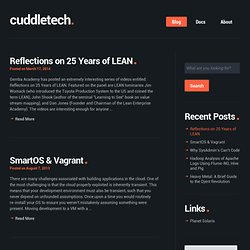
Featured on the panel are LEAN luminaries Jim Womack (who introduced the Toyota Production System to the US and coined the term LEAN), John Shook (author of the seminal "Learning to See" book on value stream mapping), and Dan Jones (Founder and Chairman of the Lean Enterprise Academy). The videos are interesting enough for anyone ... Read More SmartOS & Vagrant There are many challenges associated with building applications in the cloud. ZFS Cheatsheet · Col's Tech. ZFS on Linux. ZFS on Linux.
Linux. Nexenta. Opensolaris.